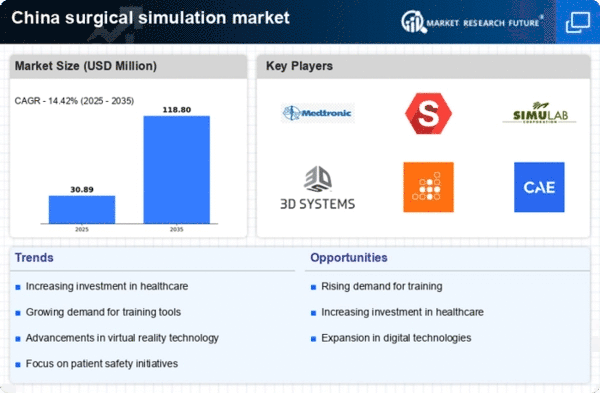Government Initiatives and Funding
Government initiatives play a crucial role in shaping the surgical simulation market in China. The Chinese government has recognized the importance of advanced medical training and has allocated substantial funding to support the development and implementation of surgical simulation technologies. Recent reports indicate that government funding for healthcare innovation has increased by over 20% in the past year, with a significant portion directed towards simulation-based training programs. These initiatives aim to enhance the quality of surgical education and improve overall healthcare outcomes. By fostering collaboration between public and private sectors, the government is creating an environment conducive to innovation in the surgical simulation market. This support not only facilitates the adoption of cutting-edge technologies but also encourages research and development, ultimately benefiting medical professionals and patients alike.
Rising Demand for Surgical Training
The The surgical simulation market in China is experiencing a notable increase in demand for advanced surgical training solutions. As the healthcare sector evolves, there is a growing emphasis on enhancing the skills of medical professionals. This trend is driven by the need for improved patient outcomes and the reduction of surgical errors. According to recent data, the surgical simulation market is projected to grow at a CAGR of approximately 15% over the next five years. This growth is indicative of the increasing recognition of the importance of simulation-based training in surgical education. Furthermore, hospitals and medical institutions are investing significantly in simulation technologies to ensure that their surgical teams are well-prepared for complex procedures. This rising demand for surgical training solutions is a key driver in the surgical simulation market, reflecting a broader commitment to excellence in healthcare delivery.
Technological Advancements in Simulation Tools
Technological advancements are significantly influencing the surgical simulation market in China. The introduction of high-fidelity simulation tools, including virtual reality (VR) and augmented reality (AR), is transforming the way surgical training is conducted. These technologies provide immersive experiences that allow trainees to practice complex procedures in a risk-free environment. Recent data suggests that the market for VR and AR in medical training is expected to reach $1 billion by 2026, highlighting the growing interest in these innovative solutions. As medical institutions increasingly adopt these advanced tools, the surgical simulation market is likely to expand rapidly. The integration of artificial intelligence (AI) into simulation platforms further enhances the learning experience, enabling personalized training and real-time feedback. This technological evolution is a key driver of growth in the surgical simulation market, reflecting the ongoing commitment to improving surgical education.
Collaboration with Medical Device Manufacturers
Collaboration between surgical simulation market stakeholders and medical device manufacturers is emerging as a vital driver of growth in China. These partnerships facilitate the development of simulation tools that closely mimic real-world surgical environments, enhancing the training experience for medical professionals. By working together, simulation providers and device manufacturers can create realistic scenarios that incorporate the latest surgical instruments and techniques. This collaboration is particularly important as the surgical landscape continues to evolve with new technologies. Recent trends indicate that partnerships in the healthcare sector have increased by over 25% in the last year, reflecting a growing recognition of the value of integrated training solutions. As these collaborations strengthen, the surgical simulation market is likely to benefit from enhanced product offerings and improved training outcomes for healthcare professionals.
Increasing Focus on Minimally Invasive Procedures
The shift towards minimally invasive surgical techniques is a significant driver in the surgical simulation market in China. As healthcare providers aim to reduce patient recovery times and improve surgical outcomes, there is a growing need for training solutions that cater to these advanced techniques. The surgical simulation market is adapting to this trend by offering specialized training modules that focus on minimally invasive procedures. Data indicates that the adoption of minimally invasive surgeries has increased by approximately 30% in recent years, underscoring the demand for effective training solutions. This shift not only enhances patient safety but also necessitates the development of sophisticated simulation tools that accurately replicate these procedures. Consequently, the surgical simulation market is poised for growth as it aligns with the evolving landscape of surgical practices in China.

















Leave a Comment